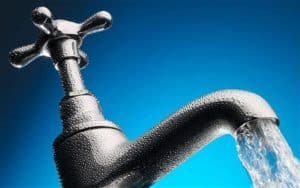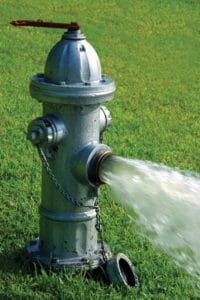ABSTRACT: A unidirectional flushing (UDF) program when properly performed can provide a unique chronological account of flow through the distribution system. While a UDF program cleans the loose debris from individual mains, it also identifies closed and/or malfunctioning valves and provides data relative to pipe friction factors. Performed year after year, a UDF program can identify the effect of recent system improvements or deterioration through comparison of annual data.
Tag: UDF program
The Criticality of Unidirectional Flushing (UDF) Programs for Water Utilities
 Water utilities today are faced with a unique set of difficulties. Population growth has resulted in unprecedented demand while climate change has caused supply to dwindle. Increased regulations have forced utilities to invest more and more capital into treatment while budgets have shrunk. In addition, our nation’s aging infrastructure has forced water utilities to heavily invest in repair and replacement of the distribution system. Therefore, it has become critical that utilities utilize the most cost-effective and efficient methodologies in order to maintain and improve their water systems.
Water utilities today are faced with a unique set of difficulties. Population growth has resulted in unprecedented demand while climate change has caused supply to dwindle. Increased regulations have forced utilities to invest more and more capital into treatment while budgets have shrunk. In addition, our nation’s aging infrastructure has forced water utilities to heavily invest in repair and replacement of the distribution system. Therefore, it has become critical that utilities utilize the most cost-effective and efficient methodologies in order to maintain and improve their water systems.
A key issue in distribution systems is tuberculation, or build-up, on distribution pipe walls. These deposits, most frequently caused by corrosion and microbial activity, affect both the quality and quantity of the water supply. Excessive tuberculation greatly reduces distribution system efficiency and has a negative impact on water quality. In fact, AWWA has noted that distribution system deficiencies are responsible for over 25 percent of waterborne disease outbreaks in the United States each year.

Fortunately, implementation of a planned, systematic Unidirectional Flushing (UDF) Program helps to reduce these issues. UDF is utilized to maintain a distribution system and provides the added benefit of learning critical information about the system. This information allows utilities to efficiently plan and make the most imperative improvements to the system. And while the primary goal of UDF is to clean water mains, there are also several peripheral benefits. A routinely implemented UDF Program helps to regularly exercise hydrants and valves, prolonging the life of the valves and helping to locate any closed or broken valves. Flushing also helps to pinpoint the cause of water quality or pressure issues in a specific area of the system while determining discrepancies between the hydraulic model and the distribution system. Flushing frequently enables system issues to be discovered before they become critical and require emergency service, giving utilities sufficient time to address and budget them.
 Because demand is highest in summer and would make flushing impractical, and low temperatures in winter would cause unsafe conditions from flushed water freezing on roadways and sidewalks, flushing is typically performed in the spring and fall. Currently, Tata & Howard is assisting the communities of Haverhill and Manchester By The Sea, MA and Norwalk First Taxing District in Norwalk, CT with their annual UDF Programs. Both AWWA and MassDEP recommend that UDF be performed on an annual basis, at a minimum. If a distribution system is too large to perform UDF annually, flushing should instead be scheduled in rotation so that all parts of the distribution system are exercised on a regular basis.
Because demand is highest in summer and would make flushing impractical, and low temperatures in winter would cause unsafe conditions from flushed water freezing on roadways and sidewalks, flushing is typically performed in the spring and fall. Currently, Tata & Howard is assisting the communities of Haverhill and Manchester By The Sea, MA and Norwalk First Taxing District in Norwalk, CT with their annual UDF Programs. Both AWWA and MassDEP recommend that UDF be performed on an annual basis, at a minimum. If a distribution system is too large to perform UDF annually, flushing should instead be scheduled in rotation so that all parts of the distribution system are exercised on a regular basis.
A regularly scheduled UDF Program is one of the simplest and most cost-effective ways of maintaining the health and safety of a water distribution system. For comprehensive information on UDF Programs including case studies, please download our UDF whitepaper instantly here.
